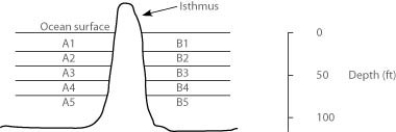Multiple Choice
Use the following description to answer the question.
In the oceans on either side of the Isthmus of Panama are 30 species of snapping shrimp; some are shallow-water species, others are adapted to deep water. There are 15 species on the Pacific side and 15 different species on the Atlantic side. The Isthmus of Panama started rising about 10 million years ago. The oceans were completely separated by the isthmus about 3 million years ago.
In the figure, the isthmus separates the Pacific Ocean on the left (side A) from the Atlantic Ocean on the right (side B) . The seawater on either side of the isthmus is separated into five depth habitats (1-5) , with 1 being the shallowest.
Which factor is most important for explaining why there are equal numbers of snapping shrimp species on either side of the isthmus?
A) the relative shortness of time they have been separated
B) the depth of the sea
C) the number of actual depth habitats between the surface and the sea floor
D) the elevation of the isthmus above sea level
Correct Answer:

Verified
Correct Answer:
Verified
Q12: Suppose that a group of male pied
Q13: Use the following description to answer the
Q14: The difference between geographic isolation and habitat
Q15: Two species of frogs belonging to the
Q16: The following question refers to this hypothetical
Q18: Which of the following describes the most
Q19: Reinforcement is most likely to occur when
Q20: What does the biological species concept use
Q21: Three populations of crickets look very similar,
Q65: Dog breeders maintain the purity of breeds